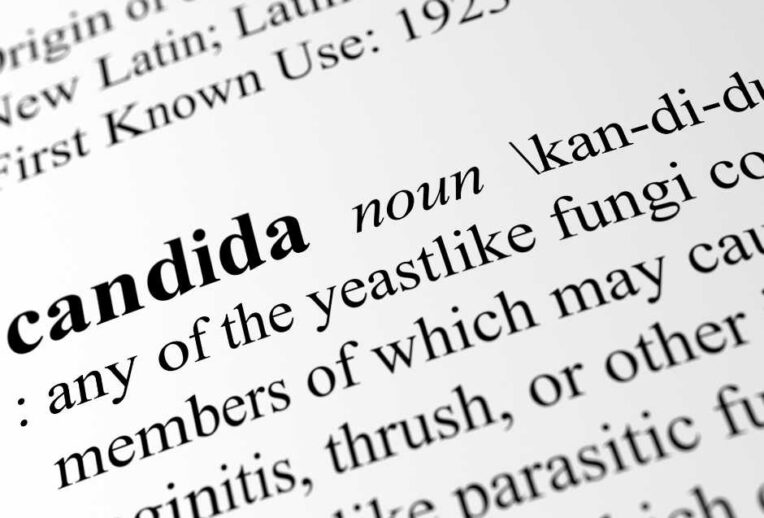Candida Overgrowth
Candida is a type of yeast or fungus that is naturally found in many areas of the human body, such as the skin, mouth, gut, and vagina. Nearly all of us have candida living in our gut as part of our normal microbial environment – it only becomes a problem if an overgrowth occurs – this is called candidiasis, but may also be termed a yeast/fungal/candida infection, or thrush.
Symptoms
The symptoms will vary depending on where the overgrowth has occurred, and how severe the infection is. Here’s a breakdown of some of the common sites, and the signs of an infection.
- Skin: redness, itchiness or a rash. Common sites include inside of elbows, back of knees, and folds of the skin as well as under the toenails.
- Mouth/throat (aka oral thrush): redness, inflammation, soreness of the inside of the mouth/throat, difficulty in swallowing. You may see white spots inside the mouth or coating the tongue.
- Genital: may present as irritation, itching, or redness, discharge, increased urge to urinate, and burning sensation whilst peeing may also be present.
- Gut (aka small intestinal fungal overgrowth (SIFO)): nausea, stomach pain, bloating, constipation, or diarrhoea.
Causes
The immunocompromised are more at risk of developing candidiasis – these individuals may include those on chemotherapy, type 1 diabetics, and those with HIV.
We also know that yeast is opportunistic and competes for space within our gut microbiome. So for someone who has prolonged use of antibiotics which may reduce the bacterial diversity within the intestine, it may give candida the space it needs to flourish. Similarly, the use of proton pump inhibitor drugs (e.g. omeprazole, lansoprazole) which are used to suppress stomach acid, has been shown to negatively affect the bacterial microbial environment giving candida the opportunity to to move into the small bowel.
Getting a diagnosis
Many of the symptoms of candida overlap with other conditions, so it is important to get a diagnosis.
In most cases, your, doctor will be able to diagnose having assessed the sites of infection, with consideration of other clinical factors. Some cases may require samples/swabs to be taken from the infected area and assessed.
To diagnose SIFO the best-evidenced method is via obtaining an aspirate of duodenal juice, which is a highly invasive procedure. We don’t yet have standardised cut-off values for what constitutes a positive diagnosis which means obtaining a diagnosis can be tricky. In practice, therefore, clinicians tend to rule out other conditions first (such as SIBO – see our other post on this) and if symptoms remain unexplained then SIFO/candida overgrowth could be suggested.
Treatment
Medical Treatment
Antifungal medications are an evidence-based approach to treating candida and are commonly prescribed by Drs / physicians to treat the cause of infection. These may be taken orally or applied to the skin depending on need.
Sometimes a diagnosis of SIFO is only obtained once a trial of these antifungals has been prescribed – an improvement in symptoms would suggest SIFO.
What about The Candida Diet?
Frequently we hear of cases where individuals have sought dietary methods to treat candida (of the gut, but also other sites). The Candida Diet (or Anti-Candida Diet) is a diet that reduces the amount and type of certain sugars in our diet. It was born from the thought that if we reduce or eliminate sugar from our diet, we are in essence not feeding the candida.
There are no standardised principles of exclusion, but usually, a Candida style diet will involve variations of the following:
- Removing carbohydrate (bread, pasta, cereals) which are broken down into simple sugars
- Avoiding high sugar foods
- Avoiding foods which contain yeast – bread, beer, wine, vinegars
- May require exclusion of dairy
- The use of probiotics both food and supplement sources
- Some variations of this diet may advocate episodes of intermittent fasting
The Gut Health Clinic Breakdown
Generally speaking, the Candida Diet triggers our ‘red flag’ alert for being a diet that restricts whole foods/ food groups without credible data to back it up.
We often hear individuals reporting their symptoms have improved following this type of diet. However, when we take a closer look, it may be other factors of the diet which trigger gut symptoms that have been eliminated during the process of restriction. For example, reducing intake of alcohol or heavily processed foods, or simply eating more fresh / plant-based foods during the phase of restriction.
Given the level of restriction, the Candida Diet may increase the risk of nutritional deficiencies, and contribute to other issues around our health which can be dangerous especially if someone is already immunocompromised. Whilst garlic, which is often recommended, may be useful in targeting candida if someone has IBS the garlic can trigger or worsen gastrointestinal symptoms. It’s worth noting that whilst most herbs recommended to treat candida are safe and beneficial to include in the diet, some should be used with caution. It’s always important to check with your oncology team if you’re on chemotherapy and considering a herbal supplement as there are sometimes drug-herb interactions.
Unfortunately, there is little, strong scientific research to recommend the Candida Diet as a treatment for overgrowth, and because of the restrictive nature of it, this diet gets a no from us. Our verdict is that following a diet rich in plant-based goodness and diversity, and minimising sugar and processed foods is the best way of optimising our gut and immune health in this scenario.
What about probiotics?
Probiotics are often recommended to repopulate the gut microbiome so that the balance can be restored and the immune system is supported. But what’s the evidence when it comes to candida?
The answer is unfortunately that it is not yet conclusive. One strain of probiotic has shown to be potentially useful in the treatment of candida: – Lactobacillus acidophilus produces hydrogen peroxide which can slow/stop the growth of the most predominant candida species. Studies have found a decrease in candida infection recurrence after taking probiotics, whilst other studies found no change at all.
Whilst there is still some ongoing research into the role of probiotics in the management of Candida, it is still too early to draw any conclusions from this. Rather than reaching for the supplements, consider probiotics from foods like yogurt, sauerkraut, miso, kombucha, sour cream and kefir.
Conclusion
If you suspect you’re suffering with candida overgrowth you should consult your doctor in the first instance. Consider seeking advice from a gastroenterologist and gut specialist dietitian if needed. Steer clear of diets that recommend cutting out carbs completely (we need them for our overall health!). If you’re not sure about probiotics, focus on food sources which can be enjoyed within the diet.
This blog was authored by Tanzil Miah, an IBD and surgical specialist dietitian.












